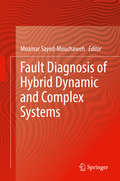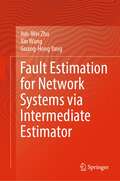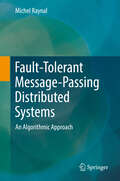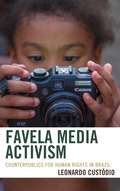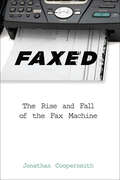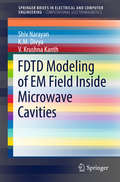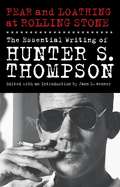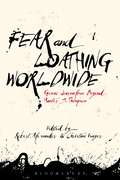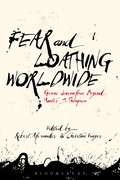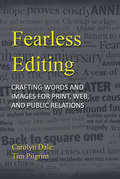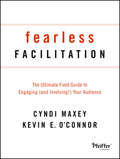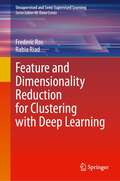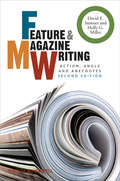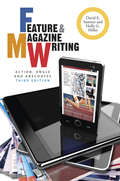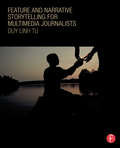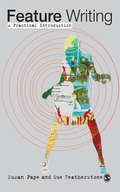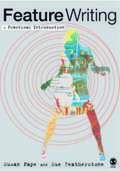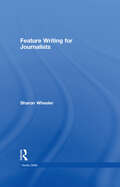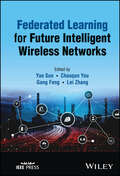- Table View
- List View
Fault Diagnosis of Hybrid Dynamic and Complex Systems
by Moamar Sayed-MouchawehOnline fault diagnosis is crucial to ensure safe operation of complex dynamic systems in spite of faults affecting the system behaviors. Consequences of the occurrence of faults can be severe and result in human casualties, environmentally harmful emissions, high repair costs, and economical losses caused by unexpected stops in production lines. The majority of real systems are hybrid dynamic systems (HDS). In HDS, the dynamical behaviors evolve continuously with time according to the discrete mode (configuration) in which the system is. Consequently, fault diagnosis approaches must take into account both discrete and continuous dynamics as well as the interactions between them in order to perform correct fault diagnosis. This book presents recent and advanced approaches and techniques that address the complex problem of fault diagnosis of hybrid dynamic and complex systems using different model-based and data-driven approaches in different application domains (inductor motors, chemical process formed by tanks, reactors and valves, ignition engine, sewer networks, mobile robots, planetary rover prototype etc.). These approaches cover the different aspects of performing single/multiple online/offline parametric/discrete abrupt/tear and wear fault diagnosis in incremental/non-incremental manner, using different modeling tools (hybrid automata, hybrid Petri nets, hybrid bond graphs, extended Kalman filter etc.) for different classes of hybrid dynamic and complex systems.
Fault Estimation for Network Systems via Intermediate Estimator
by Jun-Wei Zhu Xin Wang Guang-Hong YangThis book is concerned with the fault estimation problem for network systems. Firstly, to improve the existing adaptive fault estimation observer, a novel so-called intermediate estimator is proposed to identify the actuator or sensor faults in dynamic control systems with high accuracy and convergence speed. On this basis, by exploiting the properties of network systems such as multi-agent systems and large-scale interconnected systems, this book introduces the concept of distributed intermediate estimator; faults in different nodes can be estimated simultaneously; meanwhile, satisfactory consensus performances can be obtained via compensation based protocols. Finally, the characteristics of the new fault estimation methodology are verified and discussed by a series of experimental results on networked multi-axis motion control systems. This book can be used as a reference book for researcher and designer in the field of fault diagnosis and fault-tolerant control and can also be used as a reference book for senior undergraduate and graduate students in colleges and universities.
Fault-Tolerant Message-Passing Distributed Systems: An Algorithmic Approach
by Michel RaynalThis book presents the most important fault-tolerant distributed programming abstractions and their associated distributed algorithms, in particular in terms of reliable communication and agreement, which lie at the heart of nearly all distributed applications. These programming abstractions, distributed objects or services, allow software designers and programmers to cope with asynchrony and the most important types of failures such as process crashes, message losses, and malicious behaviors of computing entities, widely known under the term "Byzantine fault-tolerance". The author introduces these notions in an incremental manner, starting from a clear specification, followed by algorithms which are first described intuitively and then proved correct. The book also presents impossibility results in classic distributed computing models, along with strategies, mainly failure detectors and randomization, that allow us to enrich these models. In this sense, the book constitutes an introduction to the science of distributed computing, with applications in all domains of distributed systems, such as cloud computing and blockchains. Each chapter comes with exercises and bibliographic notes to help the reader approach, understand, and master the fascinating field of fault-tolerant distributed computing.
Favela Media Activism: Counterpublics for Human Rights in Brazil (PDF)
by Leonardo CustódioWhat explains the engagement of low-income young people in media initiatives for political mobilization and social change in everyday life? Favela Media Activism: Counterpublics for Human Rights in Brazil responds to this question using an in-depth ethnographic and interdisciplinary study about the trajectories in media activism among young residents of low-income and violence-ridden favelas in socially unequal Rio de Janeiro. Leonardo Custodio provides multifaceted analyses of how favela youth engage in individual and collective media activist initiatives despite social class constraints and neoliberal imperatives in their everyday life. This book details processes experienced by young favela residents while becoming individuals who act to challenge and change patterns of discrimination, governmental neglect and drug-related violence. It is an important resource for scholars interested in the nuances of political engagement among marginalized youth in today's world of hyper-connectivity, information abundance, and the persistence of racial and social inequalities.
Faxed: The Rise and Fall of the Fax Machine (Johns Hopkins Studies in the History of Technology)
by Jonathan CoopersmithFaxed is the first history of the facsimile machineâ€�the most famous recent example of a tool made obsolete by relentless technological innovation. Jonathan Coopersmith recounts the multigenerational, multinational history of the device from its origins to its workplace glory days, in the process revealing how it helped create the accelerated communications, information flow, and vibrant visual culture that characterize our contemporary world.Most people assume that the fax machine originated in the computer and electronics revolution of the late twentieth century, but it was actually invented in 1843. Almost 150 years passed between the fax’s invention in England and its widespread adoption in tech-savvy Japan, where it still enjoys a surprising popularity. Over and over again, faxing’s promise to deliver messages instantaneously paled before easier, less expensive modes of communication: first telegraphy, then radio and television, and finally digitalization in the form of email, the World Wide Web, and cell phones. By 2010, faxing had largely disappeared, having fallen victim to the same technological and economic processes that had created it. Based on archival research and interviews spanning two centuries and three continents, Coopersmith’s book recovers the lost history of a once-ubiquitous technology. Written in accessible language that should appeal to engineers and policymakers as well as historians, Faxed explores themes of technology push and market pull, user-based innovation, and "blackboxing" (the packaging of complex skills and technologies into packages designed for novices) while revealing the inventions inspired by the fax, how the demand for fax machines eventually caught up with their availability, and why subsequent shifts in user preferences rendered them mostly passé.
FDTD Modeling of EM Field inside Microwave Cavities (SpringerBriefs in Electrical and Computer Engineering)
by Shiv Narayan K. M. Divya V. Krushna KanthThis book deals with the EM analysis of closed microwave cavities based on a three-dimensional FDTD method. The EM analysis is carried out for (i) rectangular microwave ovens and (ii) hybrid-cylindrical microwave autoclaves at 2.45 GHz. The field distribution is first estimated inside domestic rectangular ovens in xy-, yz-, and zx-plane. Further, the RF leakage from the oven door is determined to study the effect of leakage radiation on wireless communication at 2.45 GHz. Furthermore, the EM analysis of the autoclave is carried out based on 3D FDTD using staircase approximation. In order to show the capability of autoclaves (excited with five source) for curing the aerospace components and materials, the field distribution inside autoclave cavity is studied in presence of aerospace samples. The FDTD based modelling of oven and autoclave are explained with the appropriate expressions and illustrations.
Fear and Loathing at Rolling Stone: The Essential Writing of Hunter S. Thompson
by Hunter S. ThompsonA compilation of the subversive, important and entertaining writer of Hunter S. Thompson - renowned American writer of Fear and Loathing in Las Vegas'It would not do to be found in the desert under these circumstances: firing wildly into the cactus from a car full of drugs...'Fear and Loathing at Rolling Stone showcases the evolution of the writer of Fear and Loathing in Las Vegas and Hell's Angels, through his work at the magazine that he helped to put on the map. Jann S. Wenner, Hunter Thompson's editor and friend for nearly thirty-five years, has chosen the pieces, including many never collected before. They show how Thompson's Rolling Stone writing, when taken as a whole, forms an extended, allusive autobiography of the writer himself as he pursues his lifelong obsession, the king-hell story of them all: The Death of the American Dream.
Fear and Loathing Worldwide: Gonzo Journalism Beyond Hunter S. Thompson
by Robert Alexander Christine IsagerFor more than 40 years, the radically subjective style of participatory journalism known as Gonzo has been inextricably associated with the American writer Hunter S. Thompson. Around the world, however, other journalists approach unconventional material in risky ways, placing themselves in the middle of off-beat stories, and relate those accounts in the supercharged rhetoric of Gonzo. In some cases, Thompson's influence is apparent, even explicit; in others, writers have crafted their journalistic provocations independently, only later to have that work labelled "Gonzo." In either case, Gonzo journalism has clearly become an international phenomenon. In Fear and Loathing Worldwide, scholars from fourteen countries discuss writers from Europe, the Americas, Africa and Australia, whose work bears unmistakable traces of the mutant Gonzo gene. In each chapter, "Gonzo" emerges as a powerful but unstable signifier, read and practiced with different accents and emphases in the various national, cultural, political, and journalistic contexts in which it has erupted. Whether immersed in the Dutch crack scene, exploring the Polish version of Route 66, following the trail of the 2014 South African General Election, or committing unspeakable acts on the bus to Turku, the writers described in this volume are driven by the same fearless disdain for convention and profound commitment to rattling received opinion with which the "outlaw journalist" Thompson scorched his way into the American consciousness in the 1960s, '70s, and beyond.
Fear and Loathing Worldwide: Gonzo Journalism Beyond Hunter S. Thompson
by Robert Alexander Christine IsagerFor more than 40 years, the radically subjective style of participatory journalism known as Gonzo has been inextricably associated with the American writer Hunter S. Thompson. Around the world, however, other journalists approach unconventional material in risky ways, placing themselves in the middle of off-beat stories, and relate those accounts in the supercharged rhetoric of Gonzo. In some cases, Thompson's influence is apparent, even explicit; in others, writers have crafted their journalistic provocations independently, only later to have that work labelled "Gonzo." In either case, Gonzo journalism has clearly become an international phenomenon. In Fear and Loathing Worldwide, scholars from fourteen countries discuss writers from Europe, the Americas, Africa and Australia, whose work bears unmistakable traces of the mutant Gonzo gene. In each chapter, "Gonzo" emerges as a powerful but unstable signifier, read and practiced with different accents and emphases in the various national, cultural, political, and journalistic contexts in which it has erupted. Whether immersed in the Dutch crack scene, exploring the Polish version of Route 66, following the trail of the 2014 South African General Election, or committing unspeakable acts on the bus to Turku, the writers described in this volume are driven by the same fearless disdain for convention and profound commitment to rattling received opinion with which the "outlaw journalist" Thompson scorched his way into the American consciousness in the 1960s, '70s, and beyond.
Fearless Editing: Crafting Words and Images for Print, Web, and Public Relations
by Carolyn Dale Tim PilgrimFearless Editing clearly articulates the basic concepts underlying editing techniques and demonstrates their application for newspapers, public relations, magazines and Web pages. This text takes a conceptual approach that integrates verbal skills with visual elements. Unlike other texts that are clearly designed for print, this book includes multi-media applications in every chapter.
Fearless Editing: Crafting Words and Images for Print, Web, and Public Relations
by Tim Pilgrim Carolyn DaleFearless Editing clearly articulates the basic concepts underlying editing techniques and demonstrates their application for newspapers, public relations, magazines and Web pages. This text takes a conceptual approach that integrates verbal skills with visual elements. Unlike other texts that are clearly designed for print, this book includes multi-media applications in every chapter.
Fearless Facilitation: The Ultimate Field Guide to Engaging (and Involving!) Your Audience
by Cyndi Maxey Kevin O'ConnorAs the workforce ages and younger trainers and managers emerge, facilitation skills take on a new importance and, with the increased use of social networks, new facilitation skills are needed. Written by two facilitation gurus, this book shows how to make any learning environment come alive. It outlines proven guidelines any trainer can use to unify groups, inspire creativity, and get audiences, teams, and colleagues to speak up, talk back, participate, and engage in meetings.
Fearless Facilitation: The Ultimate Field Guide to Engaging (and Involving!) Your Audience
by Cyndi Maxey Kevin O'ConnorAs the workforce ages and younger trainers and managers emerge, facilitation skills take on a new importance and, with the increased use of social networks, new facilitation skills are needed. Written by two facilitation gurus, this book shows how to make any learning environment come alive. It outlines proven guidelines any trainer can use to unify groups, inspire creativity, and get audiences, teams, and colleagues to speak up, talk back, participate, and engage in meetings.
Feature and Dimensionality Reduction for Clustering with Deep Learning (Unsupervised and Semi-Supervised Learning)
by Frederic Ros Rabia RiadThis book presents an overview of recent methods of feature selection and dimensionality reduction that are based on Deep Neural Networks (DNNs) for a clustering perspective, with particular attention to the knowledge discovery question. The authors first present a synthesis of the major recent influencing techniques and "tricks" participating in recent advances in deep clustering, as well as a recall of the main deep learning architectures. Secondly, the book highlights the most popular works by “family” to provide a more suitable starting point from which to develop a full understanding of the domain. Overall, the book proposes a comprehensive up-to-date review of deep feature selection and deep clustering methods with particular attention to the knowledge discovery question and under a multi-criteria analysis. The book can be very helpful for young researchers, non-experts, and R&D AI engineers.
Feature and Magazine Writing: Action, Angle and Anecdotes
by David E. Sumner Holly G. MillerThis fully revised and updated edition of Feature and Magazine Writing covers everything from finding original ideas to locating expert sources. With fresh perspectives and advice from professional writers and editors, this colorfully-written introduction is required reading for anyone who wishes to become a strong feature writer. Includes chapters on connecting content to the calendar, writing for online publications, trends, issues and controversies, and writing dramatic stories New chapters in this edition include 'How To Find A Magazine Job', 'Last Chance: The Final Draft', and 'Writing for Trades, Associations and Organizations' New sections in this edition include 'Improving Your Pizzazz and 'Original Research = Original Articles'
Feature and Magazine Writing: Action, Angle, and Anecdotes
by David E. Sumner Holly G. MillerUpdated with fresh facts, examples and illustrations, along with two new chapters on digital media and blogs this third edition continues to be the authoritative and essential guide to writing engaging and marketable feature stories. Covers everything from finding original ideas and angles to locating expert sources Expanded edition with new chapters on storytelling for digital media and building a story blog Captivating style exemplifies the authors’ expert guidance, combining academic authority with professional know-how Comprehensive coverage of all the angles, including marketing written work and finding jobs in the publishing industry Essential reading for anyone wishing to become a strong feature writer Accompanied by a website with a wealth of resources including PowerPoint presentations, handouts, and Q&As that will be available upon publication: www.wiley.com/go/sumnerandmiller
Feature and Magazine Writing: Action, Angle, and Anecdotes
by David E. Sumner Holly G. MillerUpdated with fresh facts, examples and illustrations, along with two new chapters on digital media and blogs this third edition continues to be the authoritative and essential guide to writing engaging and marketable feature stories. Covers everything from finding original ideas and angles to locating expert sources Expanded edition with new chapters on storytelling for digital media and building a story blog Captivating style exemplifies the authors’ expert guidance, combining academic authority with professional know-how Comprehensive coverage of all the angles, including marketing written work and finding jobs in the publishing industry Essential reading for anyone wishing to become a strong feature writer Accompanied by a website with a wealth of resources including PowerPoint presentations, handouts, and Q&As that will be available upon publication: www.wiley.com/go/sumnerandmiller
Feature and Narrative Storytelling for Multimedia Journalists
by Duy Linh TuFeature and Narrative Storytelling for Multimedia Journalists is the first text that truly focuses on the multimedia and documentary production techniques required by professional journalists. Video and audio production methods are covered in rich detail, but more importantly, various storytelling techniques are explored in depth. Likewise, author Duy Linh Tu tackles the latest topics in multimedia storytelling, including mobile reporting, producing, and publishing, while also offering best practices for using social media to help promote finished products. Whether you’re a student, a professional seeking new techniques, or simply looking to update your skills for the new digital newsroom, this book will provide you with the information and tools you need to succeed as a professional journalist. Integrated: The lessons in this book deftly combine traditional media production principles with storytelling craft. It is written with the perspective of modern professional journalists in mind. Practical: While rich with theory, this text is based on the real-world work of the author and several of his colleagues. It features Q&As with some of the best editors and video producers from top publications, including NPR, Vice, and Detroit Free Press, as well as profiles of leading video news organizations such as Frontline, Mediastorm, and Seattle Times. Proven: The author uses pedagogy from the world-renowned Columbia Journalism School as well as case studies from his own award-winning work. Interactive: The text is exercise- and drill-based, and the companion website provides multimedia examples and lesson files, as well as tutorials, case studies, and video interviews.
Feature and Narrative Storytelling for Multimedia Journalists
by Duy Linh TuFeature and Narrative Storytelling for Multimedia Journalists is the first text that truly focuses on the multimedia and documentary production techniques required by professional journalists. Video and audio production methods are covered in rich detail, but more importantly, various storytelling techniques are explored in depth. Likewise, author Duy Linh Tu tackles the latest topics in multimedia storytelling, including mobile reporting, producing, and publishing, while also offering best practices for using social media to help promote finished products. Whether you’re a student, a professional seeking new techniques, or simply looking to update your skills for the new digital newsroom, this book will provide you with the information and tools you need to succeed as a professional journalist. Integrated: The lessons in this book deftly combine traditional media production principles with storytelling craft. It is written with the perspective of modern professional journalists in mind. Practical: While rich with theory, this text is based on the real-world work of the author and several of his colleagues. It features Q&As with some of the best editors and video producers from top publications, including NPR, Vice, and Detroit Free Press, as well as profiles of leading video news organizations such as Frontline, Mediastorm, and Seattle Times. Proven: The author uses pedagogy from the world-renowned Columbia Journalism School as well as case studies from his own award-winning work. Interactive: The text is exercise- and drill-based, and the companion website provides multimedia examples and lesson files, as well as tutorials, case studies, and video interviews.
Feature Writing: A Practical Introduction
by Susan Featherstone Susan PapeThis book provides a practical and richly informative introduction to feature writing and the broader context in which features journalists operate. As well as covering the key elements and distinctive features that constitute good feature writing, the book also offers a rich resource of real life examples, case studies and exercises. The authors have drawn on their considerable shared experience to provide a solid and engaging grounding in the principles and practice of feature writing. The textbook will explore the possibilities of feature writing, including essential basics, such as: Why journalists become feature writers The difference between news stories and features What features need to contain How to write features The different types of features The text is intended for both those who are studying the media at degree level and those who are wishing to embark on a career in the print industry. It will be invaluable for trainee feature writers.
Feature Writing: A Practical Introduction (PDF)
by Susan Pape Susan FeatherstoneThis book provides a practical and richly informative introduction to feature writing and the broader context in which features journalists operate. As well as covering the key elements and distinctive features that constitute good feature writing, the book also offers a rich resource of real life examples, case studies and exercises. The authors have drawn on their considerable shared experience to provide a solid and engaging grounding in the principles and practice of feature writing. The textbook will explore the possibilities of feature writing, including essential basics, such as: Why journalists become feature writers The difference between news stories and features What features need to contain How to write features The different types of features The text is intended for both those who are studying the media at degree level and those who are wishing to embark on a career in the print industry. It will be invaluable for trainee feature writers.
Feature Writing for Journalists (Media Skills)
by Sharon WheelerFeature Writing for Journalists considers both newspapers and magazines and helps the new or aspiring journalist to become a successful feature writer. Using examples from a wide range of papers, specialist and trade magazines and 'alternative' publications, Sharon Wheeler considers the different types of material that come under the term 'feature' including human interest pieces, restaurant reviews and advice columns. With relevant case studies as well as interviews with practitioners, Feature Writing for Journalists is exactly what you need to understand and create exciting and informative features.
Feature Writing for Journalists (Media Skills)
by Sharon WheelerFeature Writing for Journalists considers both newspapers and magazines and helps the new or aspiring journalist to become a successful feature writer. Using examples from a wide range of papers, specialist and trade magazines and 'alternative' publications, Sharon Wheeler considers the different types of material that come under the term 'feature' including human interest pieces, restaurant reviews and advice columns. With relevant case studies as well as interviews with practitioners, Feature Writing for Journalists is exactly what you need to understand and create exciting and informative features.
Federated Learning for Future Intelligent Wireless Networks
by Yao Sun Chaoqun You Gang Feng Lei ZhangFederated Learning for Future Intelligent Wireless Networks Explore the concepts, algorithms, and applications underlying federated learning In Federated Learning for Future Intelligent Wireless Networks, a team of distinguished researchers deliver a robust and insightful collection of resources covering the foundational concepts and algorithms powering federated learning, as well as explanations of how they can be used in wireless communication systems. The editors have included works that examine how communication resource provision affects federated learning performance, accuracy, convergence, scalability, and security and privacy. Readers will explore a wide range of topics that show how federated learning algorithms, concepts, and design and optimization issues apply to wireless communications. Readers will also find: A thorough introduction to the fundamental concepts and algorithms of federated learning, including horizontal, vertical, and hybrid FL Comprehensive explorations of wireless communication network design and optimization for federated learning Practical discussions of novel federated learning algorithms and frameworks for future wireless networks Expansive case studies in edge intelligence, autonomous driving, IoT, MEC, blockchain, and content caching and distribution Perfect for electrical and computer science engineers, researchers, professors, and postgraduate students with an interest in machine learning, Federated Learning for Future Intelligent Wireless Networks will also benefit regulators and institutional actors responsible for overseeing and making policy in the area of artificial intelligence.
Federated Learning for Future Intelligent Wireless Networks
by Chaoqun You Gang Feng Lei Zhang Yao SunFederated Learning for Future Intelligent Wireless Networks Explore the concepts, algorithms, and applications underlying federated learning In Federated Learning for Future Intelligent Wireless Networks, a team of distinguished researchers deliver a robust and insightful collection of resources covering the foundational concepts and algorithms powering federated learning, as well as explanations of how they can be used in wireless communication systems. The editors have included works that examine how communication resource provision affects federated learning performance, accuracy, convergence, scalability, and security and privacy. Readers will explore a wide range of topics that show how federated learning algorithms, concepts, and design and optimization issues apply to wireless communications. Readers will also find: A thorough introduction to the fundamental concepts and algorithms of federated learning, including horizontal, vertical, and hybrid FL Comprehensive explorations of wireless communication network design and optimization for federated learning Practical discussions of novel federated learning algorithms and frameworks for future wireless networks Expansive case studies in edge intelligence, autonomous driving, IoT, MEC, blockchain, and content caching and distribution Perfect for electrical and computer science engineers, researchers, professors, and postgraduate students with an interest in machine learning, Federated Learning for Future Intelligent Wireless Networks will also benefit regulators and institutional actors responsible for overseeing and making policy in the area of artificial intelligence.
